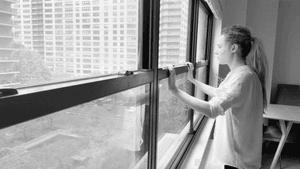Stay in the Loop
BSR publishes on a weekly schedule, with an email newsletter every Wednesday and Thursday morning. There’s no paywall, and subscribing is always free.
Dancing when the days keep coming
Works & Process Artists Virtual Commission Series presents ‘Storm’

Storm is a new dance in a novel medium that captures the pain, hope, and power of a pandemic and as well as dance itself. A solo performed by Sara Mearns, principal dancer at New York City Ballet, Storm is part of the Works & Process Artists (WPA) Virtual Commission Series.
A response to the pandemic, the series provides commissioning funds to support artists and nurture creation during these challenging times. The series includes commissions in a wide variety of genres, each less than five minutes long and created while social distancing.
At home, just like us
Storm is copresented by Barrington Stage Company, Broadway Dance Center, Kaatsbaan, the Joyce Theater, New York City Center, Jerome Robbins Dance Division at the New York Public Library for the Performing Arts, and Spoleto Festival USA. This long list does not even include those who donated time, expertise, and money, and it is an important reminder of the vast resources necessary for making and distributing art, especially these days.
Like the WPA Virtual Commission Series, Storm responds directly to COVID-19 and the mixed yet powerful emotions many of us feel in our isolation, even as we recognize how privileged we are to be able to stay home. Typically, Works & Process at the Guggenheim performances take place in the museum’s intimate theater—a gem that’s worth a visit—but Storm is set and performed in the place most people have been spending too much time in: home.
The emotional rollercoaster
Choreographer Joshua Bergasse, who also filmed the performance, and dancer Sara Mearns are married, and Storm appears to take place in their New York apartment. Bergasse restricts the movement to a limited space and uses a single dancer, which reflects the lonely confinement of quarantine. Filming in black and white heightens the effect, as it conveys the now-familiar feeling of plodding through repetitive, colorless days. Back in April, my friend, writer Cassandra Lewis, aptly described this as an underwater feeling. In May, my mother compared it to “This Way, Valerie,” a child’s singing game ending with the lines, “Here comes another one, just like the other one.” During the pandemic, the ones that keep coming are days that seem exactly like the day before.
Bergasse, who has choreographed extensively for musicals and television, created Storm in a contemporary style that incorporates elements of ballet and modern, from the former’s pirouettes and airy vertical kicks to the latter’s grounding in the earth. This combination evokes the emotional rollercoaster many of us have been riding. Level changes help depict highs and lows, and they combine with varied tempo to keep the dance interesting. Storm also makes compelling use of gesture. Mearns lifts her hands to the sky in prayer or desperation, then lies on the floor kicking her feet in frustration or despair. She also coveys feeling silent and stifled through gesture, from covering her mouth to crossing her hands over her throat.
Resignation and resolve
But Mearns’s facial expressions communicate most powerfully, revealing a skill set that includes nuanced acting as well as beautiful dancing. In her artist statement, she explains that she and Bergasse recorded “at the height of the pandemic in New York City,” as infection and death rates increased daily. Feeling lost and helpless, Mearns began to question her role in and contribution to society. Storm “allowed me to express the pain I was in,” she says.
Yet the resignation on her face as she looks out at the suggestion of a gray city beyond her window is matched by a different kind of resignation as she dances, doing it because she must, even without live audiences or theaters. Mearns’s expression speaks movingly of resolve—for surviving, and doing what we must to persevere, which includes making art and insisting upon its importance.
Dancer and choreographer make evocative use of the space, which includes the window, a motionless family pet, a guitar silent in its stand, and the chair in which Mearns listlessly sits before the dance begins. Fittingly, Mearns wears stay-at-home attire and hair: sneakers, leggings, a roomy shirt, and a loose ponytail with visible roots. Margo Seibert’s vocals lend depth to Zoe Sarnak’s dare-you-not-to-cry original song, “The Storm Will Pass Soon Now.” Lee Cherry’s elegant editing includes well chosen close-ups of Mearns’s expressive face. Combined, these features pack a lot of punch into just a few minutes.
When storms keep coming
The quarantined viewer will recognize the conflicting feelings in Storm. Like NEW YORK NEW YORK, the gorgeously devastating short film by Spike Lee he shared on Instagram last month, Storm uses image and song to communicate the pain and hope of waiting for the storm of pandemic to pass. As the storms keep coming during this time of reckoning with white supremacy, racist violence, and injustice, Storm offers ways to explore feelings and connect with others.
What, When, Where
Works & Process at the Guggenheim premieres Storm, part of the Works & Process Artists Virtual Commission Series. Sara Mearns performs choreography by Joshua Bergasse set to original music composed by Zoe Sarnak. Stream the series for free here.
Sign up for our newsletter
All of the week's new articles, all in one place. Sign up for the free weekly BSR newsletters, and don't miss a conversation.

 Melissa Strong
Melissa Strong